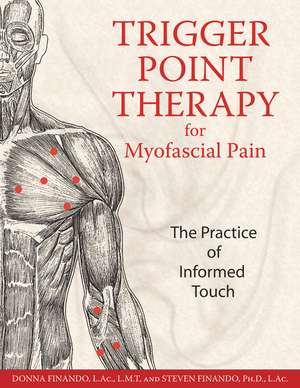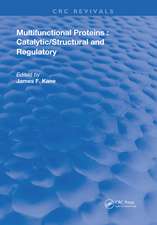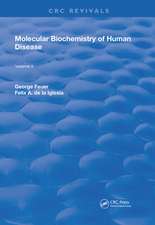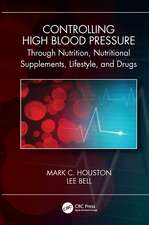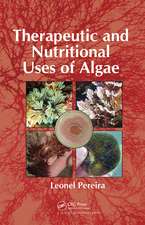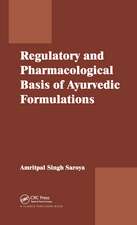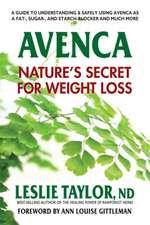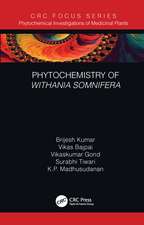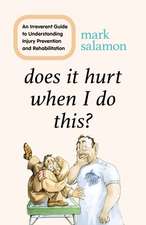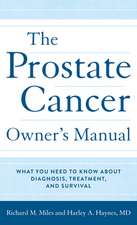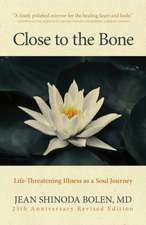Trigger Point Therapy for Myofascial Pain: The Practice of Informed Touch
Autor Donna Finando L.Ac., L.M.T., Steven Finando Ph.D., L.Ac.en Limba Engleză Paperback – 21 aug 2005
Myofascial pain syndromes are among the fastest growing problems that physicians, osteopaths, acupuncturists, and physical, occupational, and massage therapists encounter in their patients. In Trigger Point Therapy for Myofascial PainDonna and Steven Finando have organized vast amounts of information on treating myofascial pain into an accessible ""user's manual"" for healthcare practitioners. They examine a wide range of pain patterns and present evaluation and palpation techniques for reducing trigger points--and thereby alleviating pain--in the most clinically significant musculature of the body. This comprehensive yet easy-to-use reference guide to treatment of muscle pain begins with chapters on the concept of Qi and its relationship to myology, specific trigger point location and activation, and palpatory skill-building techniques. Subsequent sections provide detailed information on each muscle to teach clinicians to locate quickly and accurately individual points of pain and compensation. A visual index allows easy identification of the muscles that may be involved. Trigger Point Therapy for Myofascial Painprovides necessary and invaluable information for sufferers and any professional involved with myofascial disorders.
Preț: 125.55 lei
Nou
24.02€ • 25.08$ • 19.88£
Carte disponibilă
Livrare economică 14-28 martie
Specificații
ISBN-10: 1594770549
Pagini: 256
Ilustrații: 147 two-color illustrations
Dimensiuni: 213 x 276 x 18 mm
Greutate: 0.68 kg
Ediția:New Edition of Informed Touch
Editura: Inner Traditions/Bear & Company
Colecția Healing Arts Press
Locul publicării:United States
Notă biografică
Donna Finando, L.Ac., L.M.T., has taught myology and myofascial meridian therapy throughout the country for more than twenty years. Steven Finando, Ph.D., L.Ac., is currently on the advisory board for the New York Chiropractic College School of Acupuncture and Oriental Medicine. Both studied extensively with Janet Travell, M.D., a pioneer in the field of pain management. Donna and Steven live on Long Island, New York, where they have been in continual practice for the past 29 years.
Extras
How to Use This Manual
This manual provides important information in a format that can be easily and quickly accessed by both the student and the working health care practitioner, making it readily useable in the clinic or office.
In the technical body of the book, an illustration of each muscle and the locations of its common trigger points is accompanied by the following information:
Proximal attachment: The cephalad (upper) attachment, that is, the attachment closest to the head
Distal attachment: The caudad (lower) attachment, that is, the attachment farthest away from the head
Action: What the muscle moves, the purpose of its action
Palpation: Specific instructions on how to locate and palpate the muscle, including anatomical landmarks for reference
Pain pattern: An illustration of that muscle’s essential pain pattern is accompanied by a written description that also details possible extended pain patterns. Symptoms produced by the presence of trigger points in the muscle are also described.
Causative or perpetuating factors: A description of common behaviors that either produce or perpetuate the pain
Satellite trigger points: Additional muscles and muscle groups that commonly develop trigger points when there are trigger points in the muscle
Affected organ systems: Each meridian exercises influence over a specific organ or system. This section may shed additional light on the interaction between skeletal muscle and viscera.
Associated zones, meridians, and points: A statement of other areas predisposed to muscular constriction when there are trigger points in a particular muscle, to guide treatment for those practicing from an Oriental medical perspective.
Stretch exercises: Illustrations and descriptions of stretching exercises useful for that particular muscle during the healing process.
Strengthening exercises: A description of useful strengthening exercises for the muscle and associated muscle groups.
Most patients present with symptoms that are usually described as a particular pattern of pain. Some patients will also present with other symptoms, such as impaired range of motion, usually described as an inability to perform particular tasks. Other symptoms might seem less related, such as dizziness or menstrual problems. Two indexes are provided in an effort to help the practitioner quickly focus his or her attention on muscle groups that commonly relate to the pain pattern or symptoms presented by the patient: The Pain Pattern Index and the Symptom Index.
The Pain Pattern Index is a graphic index in which the pain patterns for each muscle are illustrated. The pain patterns are grouped in terms of the area affected: pain patterns that affect the neck are shown together, pain patterns that affect the anterior legs are shown together, and so on. With this information ready comparisons of patterns can be made, and specific information about the muscle groups quickly located.
Some patients may be vague about their pain, but clear on other symptoms. The Symptom Index provides common symptoms of myofascial syndromes and the page numbers of related muscles. Using the indexes to help narrow the focus to particular muscles involved, then turning to the summary information for each muscle, should help guide examination, treatment, and follow-up with the patient. This manual does not outline every muscle in the body. The muscles that have been included are those that we have found to be the most clinically significant in our years of practice.
Cuprins
Acknowledgments
Introduction: A Gathering of Forces: Toward an Era of Interdisciplinary Cooperation in the Treatment of Pain
Chapter 1 The Nature of Muscles and Trigger Points
Chapter 2 Qi, Movement, and Health
Chapter 3 Informed Touch
Chapter 4 Diagnosis and Treatment
Chapter 5 How to Use This Manual
Muscles of the Head, Neck, and Face
Sternocleidomastoid • Scalenes • Splenius Capitis • Splenius Cervicis • Posterior Cervicals • Temporalis • Masseter • Pterygoids
Muscles of the Shoulder Girdle
Trapezius • Levator Scapulae • Rhomboids • Serratus Anterior • Pectoralis Minor
Muscles of the Upper Limb
Pectoralis Major • Deltoid • Latissimus Dorsi • Teres Major • Supraspinatus • Infraspinatus • Teres Minor • Subscapularis • Biceps Brachii • Triceps Brachii • Brachialis • Brachioradialis • Hand and Finger Extensors • Hand and Finger Flexors
Muscles of the Torso
Erector Spinae • Quadratus Lumborum • Iliopsoas • Rectus Abdominis • Abdominals
Muscles of the Lower Limb
Gluteus Maximus • Gluteus Medius • Gluteus Minimus • Tensor Fasciae Latae • Piriformis • Hamstrings • Quadriceps • Adductors • Pectineus • Gracilis • Sartorius • Popliteus • Gastrocnemius • Soleus • Tibialis Posterior • Tibialis Anterior • Peroneal Muscles • Long Extensors of the Toes • Long Flexors of the Toes
Appendix 1: Meridian Pathways
Appendix 2: On Cutaneous Zones
Appendix 3: Commonly Used Acupoints
Pain Pattern Index
Symptom Index
Bibliography
Recenzii
"Never before have the disciplines of myofascial pain release and meridian therapy been so beautifully and practically connected. Simply put, this book is a must for all practitioners of hands-on medicine."
"Donna and Steven Finando have married some of the finest techniques that eastern and western physical medicine have to offer. Incredibly, they have done this in a single text, with excellent graphics, charts, and guidelines to specific soft-tissue work. This essential guide takes the place of many large volumes, especially when information is needed immediately. I highly recommend Informed Touch for not only the experienced practitioner, but for students as well."
"This insightful book points out a new direction in medical therapeutics. It clearly delineates where the energetic field of the body intersects and animates the physical structure. By acting at this intersection, true healing can take place."
". . . in addition to those professional healing touch practitioners wanting to stretch their skills or needing a good myofascial pain reference book, that I also suggest this book to those who suffer from chronic pain and those that do any sort of physical activity that could result in muscular pain and fatigue."
". . . written carefully and thoughtfully, as if gently guiding the reader into an intimate understanding of what's happening in the body when a trigger point is present."
"Any who suffer from muscle pain will find her methods specific and useful, based on her acupuncture and massage background and studies with Janet Travell, MD, a pioneer in pain management."
“The most valuable aspect of the book comes from its highly detailed illustrations, where the illustrator highlighted each body part discussed in red. This book is an excellent way to look for a stretch to relieve that specific ache or pain, and to understand that part of your body in relation to the muscular structure surrounding the area. Recommended.”
Descriere
Myofascial pain syndromes are among the fastest growing problems that physicians, osteopaths, acupuncturists, and physical, occupational, and massage therapists encounter in their patients. In Trigger Point Therapy for Myofascial PainDonna and Steven Finando have organized vast amounts of information on treating myofascial pain into an accessible ""user's manual"" for healthcare practitioners. They examine a wide range of pain patterns and present evaluation and palpation techniques for reducing trigger points--and thereby alleviating pain--in the most clinically significant musculature of the body. This comprehensive yet easy-to-use reference guide to treatment of muscle pain begins with chapters on the concept of Qi and its relationship to myology, specific trigger point location and activation, and palpatory skill-building techniques. Subsequent sections provide detailed information on each muscle to teach clinicians to locate quickly and accurately individual points of pain and compensation. A visual index allows easy identification of the muscles that may be involved. Trigger Point Therapy for Myofascial Painprovides necessary and invaluable information for sufferers and any professional involved with myofascial disorders.
